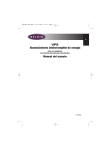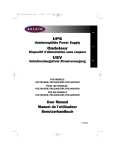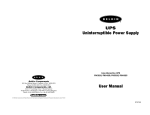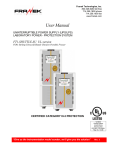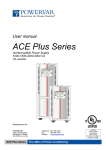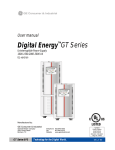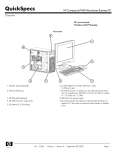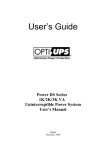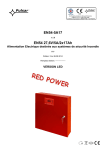Download Belkin F6C1400-EUR User manual
Transcript
UK En UPS Uninterruptible Power Supply FOR MODELS: F6C700-EUR/F6C1000-EUR/F6C1400-EUR User Manual P73335 Language Table of Contents UK En English . . . . . . . . . . . . . . . . . . . . . . . . . . . . . . . . . . . . . . . . . . . . 1 Table of Contents Section Page 1. Safety Instructions ..........................................................................1 2. Introduction ....................................................................................3 3. Installation ......................................................................................9 4. Operation......................................................................................11 5. Maintenance..................................................................................16 6. Replacing Battery..........................................................................16 7. Troubleshooting ............................................................................19 8. Communication Interface..............................................................21 9. Specifications ................................................................................24 10. Appendix A: Typical Run Time......................................................26 1. Important Safety Instructions En 1-2 TUV Safety Instruction • Please observe the following precautions to ensure personnel safety and reliable equipment observation: • The sound pressure level at the operator’s position according to IEC 704-1:1982 is equal or less than 70dB(A). For installation: • The unit should be installed by service personnel only. • Upon installation, it should be ensured that the sum of leakage current of the UPS and the connected consumer does not exceed 3.5mA. • The socket outlet should be located near the equipment and easy to access. Other safety instructions: • The UPS contains voltages which are potentially hazardous. All repairs should be performed by qualified service personal. The UPS has its own internal energy source (battery). The output receptacles may be alive even when the UPS is not connected to the mains. • When replacing batteries, always use the same type and quantity as the previous one. Batteries of GP1270-F2(CSB 12V/7AH*2) for 450VA and 700VA; GP12110-F2(CSB 12V/11AH*2) for 1000VA, and GP12170-B1 (CSB 12V/17AH*2) for 1400VA models. • Do not dispose the battery or batteries in fire as this may explode. • Do not open or mutilate the battery or batteries as released electrolyte is toxic and harmful to skin and eyes. • A battery can present a risk of electric shock and high short circuit current. The following precaution should be observed when working on batteries. • Remove watches, rings, or other metal objects. • Use tools with insulated handles. • The equipment is to be operated by fully trained personnel. 1 Safety Instructions (continued) EC Conformity Declaration The devices comply with the regulations of the following guidelines: • 73/23/EEC guideline of the Council for approximation of the legal regulations of the EC countries concerning the electrical apparatus within certain voltage tolerances, modified by the guide-line RL 93/68/EEC of the Council. • 89/336/EEC guideline of the Council for approximation of the legal regulations of the EC countries concerning the electromagnetic compatibility, modified by the guide-lines RL 91/236/EEC and 93/68/EEC of the Council. The compliance with the following standards provides the conformity: EN 50091-1-1 EN 55022, class B 2 2. Introduction En 1-3 SYMBOLS PROTECTIVE GROUNDING TERMINAL: A terminal that must be connected to earth ground prior to making any other connection to the equipment. A terminal to which or from which an alternating (sine wave) current or voltage may be applied or supplied. A terminal to which or from which a direct current or voltage may be applied or supplied. This symbol indicates the word "phase". This symbol indicates the principal on/off switch is in the ON position. This symbol indicates the principal on/off switch is in the OFF position. May be used in lieu of the wording "Caution Risk of Electric Shock" for any cautionary marking. 3 Introduction 2-1 Theory of Operation The Regulator PRO™ NetUPS Series is a line-interactive UPS with Automatic Voltage Regulation (AVR) that provides clean and reliable AC power to the computer system through the input and output EMI filter, surge suppressor and line-conditioning transformer (autotransformer) that can boost or buck-down line voltage according to the AC input voltage amplitude. In normal condition, the UPS supplies power from the utility power to the load (computer system, workstation, server or other device). The bilateral converter works as a charger to charge the battery and at the same time keeps the battery fully charged. This term is called "ON UTILITY MODE". When utility power fails, the converter supplies AC power to the load by transferring power coming from the batteries. This term is called "ON BATTERY MODE". The UPS supplies regulated power, shutdown results when battery power becomes low. BLOCK DIAGRAM OF LINE INTERACTIVE UPS AVR: Auto Voltage Regulator Utility EMI filter & Surge Suppressor BATTERY EMI filter & Surge Suppressor Bi-lateral converter AC OUTPUT 2-2 Features Intelligent Boost and Intelligent Buck-Down Line-Conditioning When brownout or over utility voltage is detected, the boost and buck-down line-conditioning will automatically adjust the incoming voltage and deliver a regulated AC power to the equipment connected to the UPS. 4 Introduction (continued) User replaceable battery The Regulator PRO™ NetUPS Series has a "user-replaceable battery function" so that users can easily swap the batteries inside the UPS by themselves. Battery replacement procedures are described in section 6. Charging current with low ripple and harmonics A special controlled circuit is used to provide charging current with PFC (Power Factor Correction). This reduces the conducted electro-magnetic interference to other facilities sharing the same distribution panel with your UPS and therefore extends the battery life of the UPS. Intelligent communication interface and powerful network support capability The built-in communication interface (RS-232 and dry contact) allows you to control and manage your UPS via powerful Belkin Sentry Bulldog Shutdown Management Software. Moreover, an optional built-in SNMP accessory slot lets your Regulator PRO™ NetUPS be easily managed through a network. User-friendly interface You can instantly assess the status of your UPS without pushing any button. The LED display provides complete and easy to understand information, such as load level, battery level, intelligent boost, intelligent buck-down, on battery, replace battery, and overload. Optional network surge protection The Regulator PRO™ NetUPS Series provides built-in Novell network cable (RJ-45) jacks. These jacks protect your hardware from surges and spikes that travel along communication lines. They protect from all potential damage as a result from surges, spikes, and line-noise. 2-3 Annotation The two signs shown below indicate that important instructions need to be followed: 5 En Introduction (continued) 2-4 Front Panel ON-TEST OFF ON BATTERY BUCK NORMAL BOOST OVERLOAD REPLACE BATTERY LOAD LEVEL BATTERY LEVEL ON/TEST: Pressing the button activates two functions. One is ON, the other is TEST. *ON: Pressing the button on the UPS and power the load. *TEST: To activate UPS self-test. It can verify both the operation of the UPS and the condition of the battery. OFF: To turn off the UPS. BUCK-DOWN LED: Indicates the UPS is correcting high utility voltage and offering a normal voltage to the load. NORMAL LED: Indicates the UPS is supplying utility power to the load without affecting the utility power condition. BOOST LED: Indicates the UPS is correcting low utility voltage and offering a normal voltage to the load. OVERLOAD LED: Indicates the UPS exceeds the acceptable rated capacity of the UPS. LOAD LEVEL LED: Displays the percentage of the loads (20%, 40%, 60%, and 80%) connected to the UPS. 6 Introduction (continued) ON BATTERY LED: Indicates the UPS is supplying the load from the battery power. REPLACE BATTERY: Indicates the UPS battery is no longer useful and must be replaced immediately. BATTERY LEVEL LED: Displays the remaining percentage of battery capacity (25%, 50%, 75%, and 100%). 2-5 Rear Panel OUTPUT RECEPTACLES: The UPS supplies AC power to the load via these receptacles. BREAKER: This is used to prevent high-input current from reaching the UPS. INPUT RECEPTACLE: AC input utility power supplies to the UPS via the receptacle. SNMP SLOT: A SNMP adapter can be plugged into this port for managing UPS on the network. TVSS SURGE PROTECTOR: This connector is used for protecting the transmission line of the Ethernet card from surges, line-noise, and spikes. COMMUNICATION INTERFACE (RS-232/DRY CONTACT): The communication port is used to allow the PC and the UPS to communicate. Please refer to section 8 for more information. 7 En Introduction (continued) Rear panel of F6C700-EUR Rear panel of F6C1000-EUR/F6C1400-EUR 8 En 3. Installation 3-1 Unpacking • Please read this user manual before installing the UPS. • This UPS contains batteries that are potentially hazardous to the user, even when the UPS is not connected to the utility power. • All repairs should be performed by qualified service personnel. • Before unpacking the UPS, check the packing box. If there is any visible damage, contact your dealer at once. 3-2 Before Installation • Avoid exposing the UPS to direct sunlight or other heat source. The UPS should be facing away from direct sunlight glare. • Choose a well-ventilated area to position your UPS to allow adequate dissipation of heat. • Ensure that the UPS surrounding area is clean and free from moisture. • Do not put heavy objects on the cable or power cord. 3-3 Installation 1. Connecting to utility power Belkin Sentry Bulldog Shutdown Management Software and RS232 cables can be used with this UPS. To use, connect the interface cable to the computer interface port on the back panel of the UPS and then connect the cable to the serial port on your PC. F6C700-EUR F6C1000-EUR/F6C1400-EUR 9 Installation (continued) 2. Charging the battery The battery charger of the UPS automatically charges the battery whenever the power cord of the UPS is connected to a normal utility power. When the UPS is running for the first time, charge the UPS for at least six hours to ensure batteries inside are fully charged before operation. You may immediately use the UPS without having to wait for the batteries to be fully charged. However, it is advisable not to do this as the UPS will have a shorter back-up time than expected if such action is taken. 3. Connecting the load Calculate the power consumption of your loads to ensure that an overload condition will not happen. Plug the equipment into the output receptacles on the rear panel of the UPS. Turn on the equipment connected to the UPS. Caution: Do not connect a laser printer to the UPS. 4. Connecting the RS-232/DRY CONTACT Connect the interface signal cable between the RS-232/DRY Contact port on the rear panel of UPS and COM1 or COM2 of the computer if necessary. The DB-9 connector can work as a dry contact or RS-232 communication port depending on the type of cable and software used. Refer to section 8 of the communication interface for more information. 10 En 4. Operation En 4-1 Cold Start when utility is not present Even with the absence of utility power, the UPS can be turned "On". Just push the ON/TEST button and wait for about two seconds for the UPS to be turned "On". The INVERTER LED will light followed by a beep and the UPS is "On". 4-2 Turning 'ON' the UPS Under normal utility power, push the ON/TEST button for the UPS to be turned "On". Once the UPS is "On", it will emit a beep and then supply power to the loads. 4-3 Turning 'OFF' the UPS Pressing the "Off" button will immediately stop the UPS from supplying power to loads. Note: It is possible that the utility power is still present even though the OFF button has been pressed. To fully turn OFF the UPS, it is advisable to unplug the power cord. 4-4 UPS Self-Test Pressing the ON/TEST button when the UPS is in "ON UTILITY MODE" will make the UPS shift to "ON BATTERY MODE" and automatically perform a self-test for about 10 seconds. After the self-test, the UPS will return to "ON UTILITY MODE". 4-5 Silence Function The buzzer can be turned "On" or "Off" by toggling the ON/TEST button when the UPS is in "ON BATTERY MODE". 11 Operation (continued) 4-6 Load Level Display The 4-LED load percentage display shows the power level (20%, 40%, 60%, 80%) drawn by the loads from the UPS. If the UPS is overloaded, the OVERLOAD LED will light. 4-7 Battery Level Display This display shows the battery capacity left in the battery. The level is represented by percentages of 25, 50, 75, and 100. These LED will extinguish gradually when using battery power. When battery capacity reaches the minimal level of 25%, the lowest LED (25%) blinks and there is an immediate need to charge the battery. Under this condition, the battery can only supply less than five minutes of run time for the load. 4-8 If certain abnormal conditions occur, the UPS will send the following messages: ON BATTERY MODE: When the UPS is in ON BATTERY MODE, the ON BATTERY LED will light, preceded by a beep every two seconds, and then the UPS will start supplying power to the load through the battery. 12 Operation (continued) OVERLOAD: If an overload occurs, the OVERLOAD LED will light and a continuous beep will be heard. Under this condition, check the load connected to the UPS. BUCK/BOOST: If the UPS encounters a high utility voltage, the function of the buck is to automatically curtail this voltage to a normal level. In the case that the UPS should come upon a low utility voltage, the boost will raise the voltage to a normal level. These two functions are represented by their respective LED on the front panel. BATTERY REPLACE: This function is to alert users of the need to replace the batteries. When the microprocessor in the UPS detects battery fault, the UPS alarm will give out three beeps. Each beep lasts for 0.5 seconds and interrupted by an interval of 0.5 seconds. After the initial three beeps, the alarm will continue to sound every one hour. 13 En Operation (continued) BATTERY LOW: This function is to inform users of the remaining power capacity of the batteries. When batteries reach a low-level condition, the UPS alarm will beep once every second and the LED on the 25% level will flash. SHORT CIRCUIT: When a short occurs in an ON UTILITY MODE, the UPS will shift to ON BATTERY MODE. If the short persists, the UPS will stop providing power to loads, alarms will sound continuously and the OVERLOAD LED will light. 14 Operation (continued) OVER TEMPERATURE When temperature inside the UPS is too high, the LED of Buck-Down, Boost, Normal, and On Battery will light, the alarm will sound continuously and, after a minute, the UPS will stop supplying power to the load. UPS FAULT When there is a breakdown on the UPS, all LEDs will light and the buzzer will sound continuously. If this happens, unplug the power cord from the wall outlet and contact service personnel. 15 En 5. Maintenance • The normal life of a battery is 3-5 years. But extreme operating conditions and environmental conditions may shorten its life-span. • To replace batteries, contact qualified personnel. • When the UPS has been unused for some time, the batteries inside will discharge slightly. It is recommended to charge the UPS once every three months. • Use a vacuum cleaner to get rid of any dust that may rest on the opening of the fan. • Unplug the UPS when it is not used for a long time. • When cleaning the plastic case or front panel, only use a soft, dry cloth. If the case or front panel is dirty, use a neutral, non-abrasive detergent. Do not use alcohol- or ammonia-based solutions. • When moving your UPS, always handle it with care. • Avoid spilling liquid on the UPS. 6. Replacing Battery EcoBattery Replacement Program In the event that the UPS needs a battery replacement, Belkin offers its EcoBattery Replacement Program. It ensures that the battery in the UPS is discarded properly in an effort to keep our environment clean. All participants in the program will receive a two-year extended product warranty. Please call Belkin Components for detailed information regarding the cost of the program and shipping procedures. +44 (0) 1604 67 8300 16 Replacing Battery (continued) The Regulator PRO™ NetUPS Series provides a convenient and easy way to replace batteries. If batteries are in poor condition, follow the proper procedure for battery replacement. 6-1 Notice • When replacing batteries, always use the same type as the previous one. • Do not dispose the battery or batteries in a fire as they may explode. • Do not open or mutilate the battery or batteries as released electrolyte is toxic and harmful to skin and eyes. • A battery may present a risk of electric shock and high short circuit current. The following precaution should be observed when replacing batteries: • Remove watches, rings, or other metal objects. • Use tools with insulated handles. 6-2 Battery Replacement Procedures 1. Hold the top of the front panel, tilt it out and pull it carefully away from the chassis. Step 1 Grasp and tilt out and down 2. Loosen the bottom of the front panel from the chassis and place it on the top of the UPS. Be cautious so as not to pull the ribbon cable and touch the LED printed circuit board. 3. Use a Phillips screwdriver to remove and open the battery door. 4. Carefully and smoothly pull the battery out of the UPS. Step 2 Place the front panel above Step 4 Pull battery out Step 3 Use a Phillips screwdriver to release the battery door 17 En Replacing Battery 5. Disconnect the battery: • For F6C700-EUR (700VA) and F6C1000-EUR (1000VA) models, disconnect the batteries and UPS by loosening the connectors. • For F6C1400-EUR (1400VA) model, disconnect the batteries and UPS by pulling apart the two white couplers that are connected together. 6. Connect the new battery: • For 700VA and 1000VA models, connect positive (+) connectors (RED-RED) and negative (-) connectors (BLACK-BLACK) together. • For 1400VA model, connect the two white connected couplers on battery and UPS together. Black (-) Red (+) Black (-) 700VA 1000VA Red (+) Push back to UPS Push back to UPS Black (-) Red (+) 1400VA Push back to UPS 7. Re-assemble the UPS as shown above. 8. For environmental protection, do not dispose old batteries anywhere. Contact your battery supplier for proper recycling of old batteries. 18 En 7. Troubleshooting PROBLEM POSSIBLE CAUSE ON/TEST button is not UPS is not turned on. (No alarm, no LED lights.) pushed. The rear panel circuit breaker is tripped. (Button is out.) SOLUTION Press the ON/TEST button to turn on the UPS. (Refer to section 4 to turn on the UPS.) 1. Reduce some loads connected to the UPS 2. Reset the circuit breaker. (Push button in.) UPS does not provide expected back-up time. UPS fault Call for qualified service personnel if above actions do not solve the problem. Batteries inside the UPS are not fully charged. Recharge the batteries for at least four hours. UPS is overloaded. Remove some unnecessary loads. Batteries are weak. Batteries wear faster when used often or operating at higher temperature. If the battery is near the end of its life, replace the battery even if the REPLACE BATTERY LED does not light. (Refer to section 6 for replacing batteries.) Batteries are weak. 19 Call for service. Troubleshooting PROBLEM All LEDs light. POSSIBLE CAUSE Internal UPS fault. SOLUTION 1. Turn off UPS. 2. Call for service. 'REPLACE BATTERY' LED lights. Weak batteries. 1. Recharge the batteries for at least 4 hours. 2. If problem remains, replace the batteries. PC-UPS communication does not work properly. Incorrect transmission speed. Incorrect RS-232 connection. UPS operates on battery even though good line voltage may be present. UPS over temperature. ( BUCK, BOOST, NORMAL, ON BATTERY LEDs light) Re-test after using another different transmission speed. Re-connect the UPS with COM1 / COM2 on PC again. The rear panel circuit breaker is tripped. (Button is out) 1. Reduce some loads connected to the UPS. Very high, low, or distorted utility voltage. Have qualified electrician check the input voltage. Wiring error such as reversed hot/neutral. Get wiring checked by electrician. The environment temperature exceeds 40°C (104°F). Position your UPS in cooler area. 20 2. Reset the circuit breaker. (Push button in) En 8. Communication Interface The Regulator PRO™ NetUPS Series has a 9-pin D-type connector that concurrently provides protocols for RS-232 and Dry contact. Using the optional software, the UPS and computer can transmit signals to each other. These two communication ports are used to control the UPS and its connector pin are defined as follows: 8-1 RS-232 NC ------------------ 1 6 ------------ NC TX ------------------ 2 7 ------------ NC RX ------------------ 3 8 ------------ NC NC ------------------ 4 9 ------------ NC Signal Ground ----- 5 Pin 2 : PC receives line RS-232 data from UPS. Pin 3 : PC transmits line RS-232 data to UPS. Pin 5 : Signal ground. Other pins: Not used. The RS-232 communication port provides the following functions: 1) Monitoring charger status 2) Monitoring battery status and condition 3) Monitoring inverter status 4) Monitoring UPS status 5) Monitoring the utility status 6) Providing the power switch function for the computer to turn on/off the utility schedule for power saving 21 Communication Interface (continued) The UPS data is provided at 2400 bps baud rate and made up of 8-bit, 1 stop-bit, and no parity bit. All information is encoded in ASCII format. HARDWARE: BAUD RATE ------------------------2400 bps DATA LENGTH --------------------8 bits STOP BIT ---------------------------1-bit PARITY ------------------------------NONE CABLING: COMPUTER UPS RX (pin2) TX (pin2) TX (pin3) RX (pin3) GND (pin5) GND (pin5) 22 Communication Interface (continued) En 8-2 Dry Contact NC ----------------- 1 6-------------- Low Battery NC ----------------- 2 7-------------- NC Shut Down-------- 3 8-------------- NC AC Fail ------------ 4 9-------------- NC Signal Ground ---- 5 Pin 4: Output signal transfers from HIGH to LOW when utility fails. The pin is normally at high level. Pin 6: Output signal transfers from HIGH to LOW upon low battery. The pin is normally at a high level. Pin 3: The UPS will shut down when a high level sustained for at least 3.8 seconds is applied. Pin 5: Signal ground. Other: Not used. The communication port at the back of the UPS may be connected to a computer. This port allows the computer to monitor the UPS and control the operation of the UPS in some cases. Its major functions normally include the following: • To broadcast a warning when power fails. • To close the files before the battery is exhausted. • To turn off the UPS and computers. Some computers may have a special connector to link this communication port, or require a special plug-in card, or need a special UPS monitoring software. Contact your dealer for details of different interface kits. 23 9. Specifications Voltage ELECTRICAL INPUT 191V~250V for 220V Model Line Conditioning Boost: +17%; Buck-Down: -13% 220V Model: 191V~205V (Boost); 232V~250V (Buck-Down) Frequency 50Hz Maximum Load Voltage (On Battery Mode) ELECTRICAL OUTPUT F6C700-EUR: 700VA/450W F6C1000-EUR: 1000VA/670W F6C1400-EUR: 1400VA/950W Nominal Voltage (100V/110V/120V/ 220V/230V/240V) ± 5% -10% after low battery warning, Synchronized to utility line Output Wave Form Pure Sine Wave Frequency 50Hz Transfer Time 4 ms Typically, Including Detection Time BATTERY Back-up Time Please refer to Appendix A for more details. Battery Type Sealed Lead-Acid Maintenance-Free Battery 24 Specifications (continued) Battery Number and Capacity F6C700-EUR F6C1000-EUR F6C1400-EUR Typical Recharge Time < 8 hours recharge to 90% capacity 12V/7Ah 12V/12Ah 12V/17Ah *2 *2 *2 INTERFACE Communication One female DB9 connector for RS-232 and Dry Contact Single LED Indicator Inverter, Replace Battery, Buck-Down Normal, Boost Sequenced LED Indicator Battery Level, Load Level MECHANICAL Dimension and Weight F6C700-EUR W=5.45"; H=6.15'; D=15.75"; 30.8 lbs F6C1000-EUR W=6.7"; H=8.66"; D=16.5"; 44 lbs F6C1400-EUR W=6.7"; H=8.66"; D=16.5"; 44 lbs PHYSICAL Operating Temperature 0˚C ~ 40˚C (32˚F ~ 104˚F) Relative Humidity 0 TO 95%, Non-condensing Audible Noise < 41dBA at 1m (3ft) in front of UPS panel APPROVAL Safety CE, TÜV GS, TÜV EMC EMI/RFI EC 25 En APPENDIX A: Typical Run Time F6C700-EUR (700VA/450W) Load 20% (90W) 40% (180W) 60% (270W) 80% (360W) 100% (450W) Typical Run Time 55 minutes 22 minutes 13 minutes 8 minutes 5 minutes F6C1000-EUR (1000 VA/670W) Load 20% (134W) 40% (268W) 60% (402W) 80% (536W) 100% (670W) Typical Run Time 60 minutes 24 minutes 13 minutes 9 minutes 6 minutes F6C1400-EUR (1400 VA/950W) Load 20% (190W) 40% (380W) 60% (570W) 80% (760W) 100% (950W) Typical Run Time 65 minutes 25 minutes 14 minutes 10 minutes 7 minutes 26 Information En FCC Statement DECLARATION OF CONFORMITY WITH FCC RULES FOR ELECTROMAGNETIC COMPATIBILITY We, Belkin Components, of 501 West Walnut Street, Compton CA 90220, declare under our sole responsibility that the product: F6C700-EUR to which this declaration relates: Complies with Part 15 of the FCC Rules. Operation is subject to the following two conditions: (1) this device may not cause harmful interference, and (2) this device must accept any interference received, including interference that may cause undesired operation. CE Declaration of Conformity We, Belkin Components, declare under our sole responsibility that the F6C700-EUR, to which this declaration relates, is in conformity with Generic Emissions Standard EN50081-1 and with Generic Immunity Standard EN50082-1 1992. Belkin Components Limited Lifetime Product Warranty Belkin Components warrants this product against defects in materials and workmanship for its lifetime. If a defect is discovered, Belkin will, at its option, repair or replace the product at no charge provided it is returned during the warranty period, with transportation charges prepaid, to the authorized Belkin dealer from whom you purchased the product. Proof of purchase may be required. This warranty does not apply if the product has been damaged by accident, abuse, misuse, or misapplication; if the product has been modified without the written permission of Belkin; or if any Belkin serial number has been removed or defaced. THE WARRANTY AND REMEDIES SET FORTH ABOVE ARE EXCLUSIVE IN LIEU OF ALL OTHERS, WHETHER ORAL OR WRITTEN, EXPRESSED OR IMPLIED. BELKIN SPECIFICALLY DISCLAIMS ANY AND ALL IMPLIED WARRANTIES, INCLUDING, WITHOUT LIMITATION, WARRANTIES OF MERCHANTABILITY AND FITNESS FOR A PARTICULAR PURPOSE. No Belkin dealer, agent, or employee is authorized to make any modification, extension, or addition to this warranty. BELKIN IS NOT RESPONSIBLE FOR SPECIAL, INCIDENTAL, OR CONSEQUENTIAL DAMAGES RESULTING FROM ANY BREACH OF WARRANTY, OR UNDER ANY OTHER LEGAL THEORY, INCLUDING BUT NOT LIMITED TO LOST PROFITS, DOWNTIME, GOODWILL, DAMAGE TO OR REPROGRAMMING, OR REPRODUCING ANY PROGRAM OR DATA STORED IN OR USED WITH BELKIN PRODUCTS. 27 Belkin Components 501 West Walnut Street Compton • CA • 90220 • USA Tel: 310.898.1100 Fax: 310.898.1111 Belkin Components, Ltd. Express Business Park • Shipton Way • Ô Ô Rushdenëë • NN 10 6GL • United Kingdom Tel: +44 (0) 1933 35 2000 Fax: +44 (0) 1933 31 2000 Belkin Components B.V. Diamantlaan 8 • 2132 WV Hoofddorp • The Netherlands Tel: +31 (0) 235698765 Fax: +31 (0) 235612694 Belkin Components, Ltd. 7 Bowen Cresent • West Gosford NSW 2250 • Australia Tel: +61 (2) 43254666 © 2001 Belkin Components. All rights reserved. All trade names are registered trademarks of respective manufacturers listed. P32923 28































